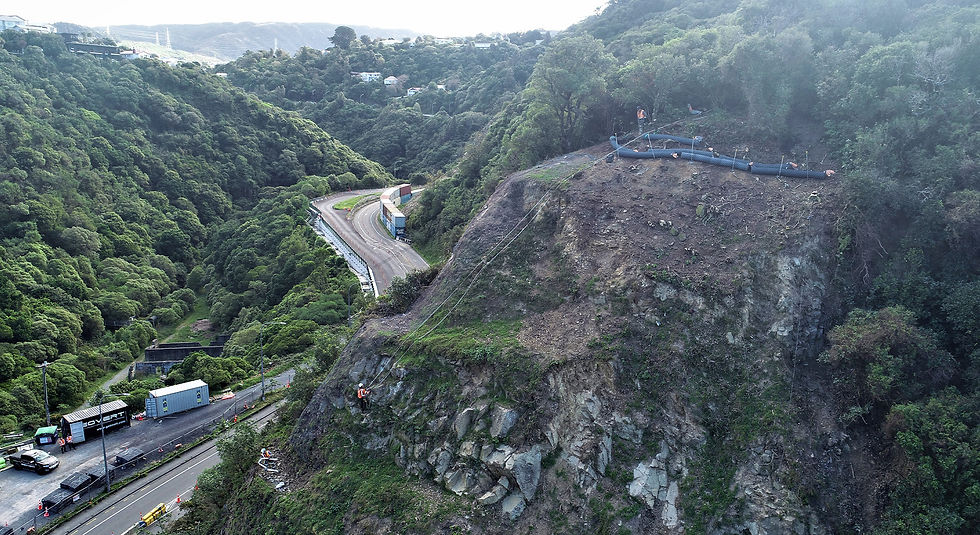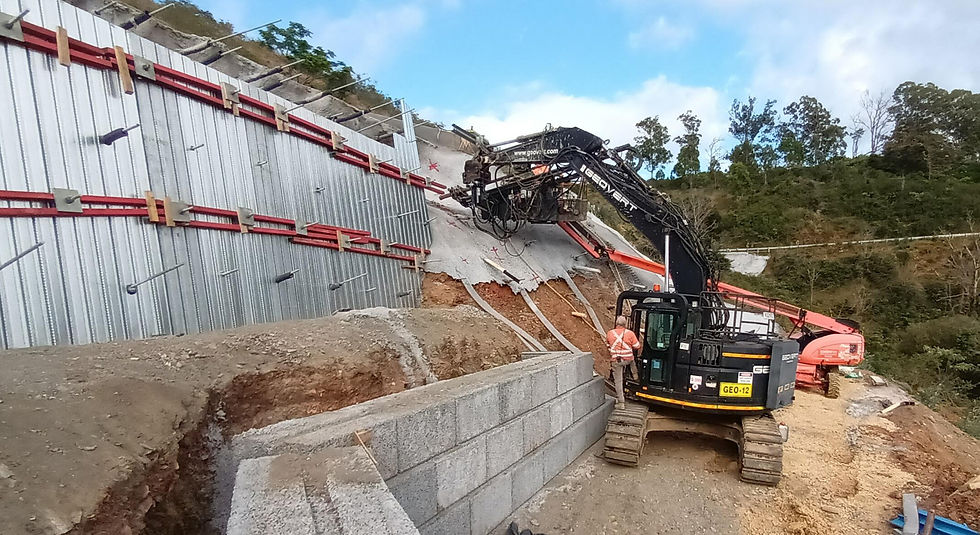Understanding Landslides – Part 2: Slope Stabilization Solutions for Landslide Mitigation
- Geovert

- Jul 20
- 4 min read
Building on our understanding of landslide mechanics and triggering factors, the focus shifts to slope stabilization solutions that protect communities and infrastructure. Effective landslide mitigation requires an approach that combines engineering intervention, environmental management, and ongoing monitoring to reduce risk and prevent future failures. Slope stabilization forms the cornerstone of this approach, directly addressing the factors that contribute to slope instability.

Approaches to Slope Stabilization
Slope stabilization strategies generally fall into three categories: avoiding the hazard, reducing the hazard through direct intervention, or accepting and managing the residual risk. Each approach demands evaluation of site conditions, potential consequences, and available resources.
Avoidance represents the most straightforward approach to how to prevent landslides in areas where development has not yet occurred. Land use planning that identifies and restricts development in high-risk zones eliminates exposure to landslide hazards. However, existing infrastructure and established communities require more sophisticated slope stabilization interventions that directly address the underlying causes of instability.
Hazard reduction through active slope stabilization forms the core of most landslide prevention systems. These engineering solutions modify the forces acting on potentially unstable slopes, either by reducing driving forces that promote movement or increasing resisting forces that maintain stability. The selection of appropriate slope stabilization techniques depends on detailed site characterization, failure mechanism analysis, and long-term performance requirements.
Drainage and Water Management Systems
Water management represents a critical component of slope stabilization, given its role as the primary triggering mechanism for most slope failures. Effective drainage systems intercept surface water before it can infiltrate unstable slopes while removing excess groundwater that reduces soil strength. These systems often work in conjunction with structural slope stabilization measures to provide complete protection.
Surface drainage solutions redirect runoff away from vulnerable slopes through interceptor ditches, berms, and engineered channels. Subsurface drainage systems, including horizontal drains, penetrate slopes to intercept groundwater and reduce pore water pressures.
Structural Slope Stabilization Techniques
Structural slope stabilization solutions involve installing engineered systems that directly resist slope movement or redistribute loads to more stable ground. These techniques prove particularly effective for protecting infrastructure where avoidance strategies are not feasible.

Retaining walls represent one of the most common structural interventions, providing direct resistance to lateral earth pressures. Gravity walls rely on their mass to resist overturning, while reinforced concrete cantilever walls use structural design to efficiently transfer loads to stable foundations. In challenging terrain where conventional construction proves difficult, modular block systems and gabion walls offer alternatives that accommodate irregular ground conditions and limited access constraints.
Soil nailing and ground anchors provide internal reinforcement that increases the effective strength of slope materials. These systems install tensioned elements through potentially unstable zones, creating composite ground conditions with improved stability characteristics. Slope stabilization mesh systems work in conjunction with these techniques, providing surface protection against rockfall and erosion while containing loose material between anchor points. The installation of soil nails, anchors, and mesh systems often requires specialized drilling equipment and rope access capabilities, particularly in steep terrain where conventional access methods prove inadequate.

Slope Modification and Grading Solutions
Geometric modifications can improve slope stability by reducing driving forces or enhancing drainage characteristics and are often used to complement structural solutions as part of landslide prevention systems. Slope flattening reduces gravitational forces by decreasing the angle of inclination, while benching creates terraced profiles that interrupt continuous failure surfaces.
The implementation of slope modification projects in challenging terrain often requires specialized construction techniques and equipment such as Spider excavators. These compact machines can operate safely on steep slopes while providing the necessary precision, making them essential tools for slope stabilization contractors operating in difficult terrain.

Debris Flow Protection and Barrier Systems
Debris flows represent a particularly dangerous form of landslide. These fast-moving mixtures of water, soil, and rock can travel great distances from their source areas, threatening infrastructure and communities in valley bottoms and alluvial fans. Effective debris flow protection systems must accommodate the high velocities and impact forces associated with these events.
Flexible landslide barrier systems and rockfall protection nets use high-strength steel mesh and energy-dissipating components to arrest debris flows while allowing controlled deformation. These systems can be installed in narrow canyon settings where rigid barriers would be impractical. The installation of flexible barriers often requires helicopter support and rope access techniques to reach optimal locations in steep terrain. These systems require regular maintenance to remove accumulated material and maintain their protective capacity.

Landslide Risk Management
Effective landslide mitigation requires the integration of multiple slope stabilization strategies tailored to specific site conditions and risk profiles. The most successful approaches combine detailed site assessment, appropriate engineering solutions, and ongoing monitoring to create comprehensive protection systems. Success depends on the expertise of slope stabilization contractors who understand both the complex geological processes involved and the practical challenges of implementing solutions in difficult terrain. As communities continue to develop in landslide-prone areas, the demand for these slope stabilization services will continue to grow.
The ultimate goal of slope stabilization is not merely to prevent individual failures but to create resilient communities that can coexist safely with dynamic geological processes. This objective requires the sustained commitment of communities, engineers and contractors working together to implement effective protection systems that reduce risk while respecting the natural processes that shape our landscapes.
For more information about slope stabilization services and specialized access capabilities, contact Geovert's team of experts who combine geological expertise with innovative solutions for challenging terrain applications.

